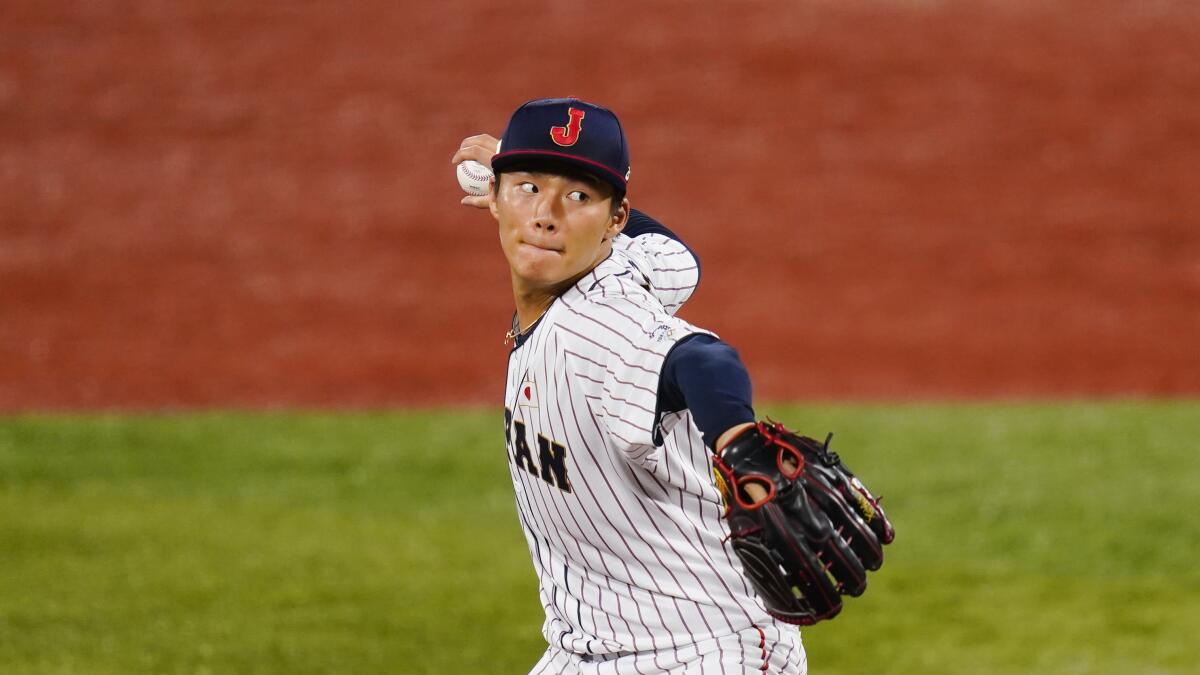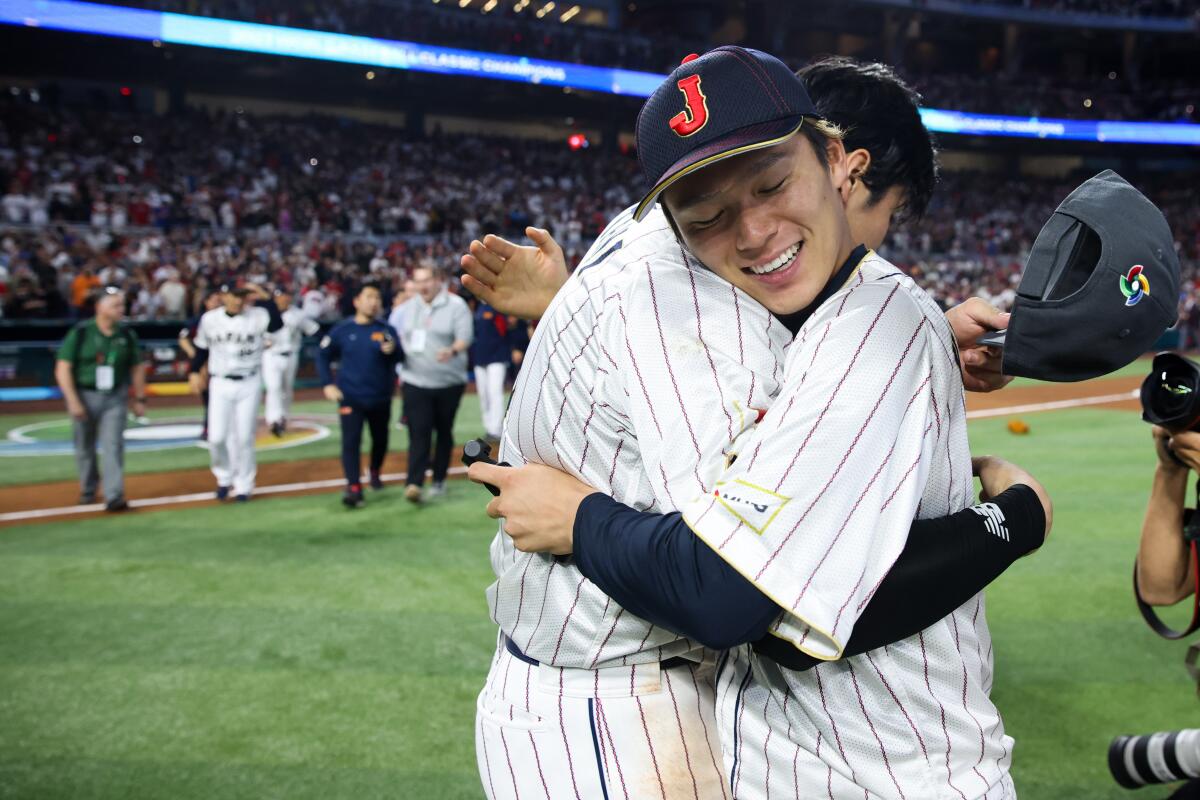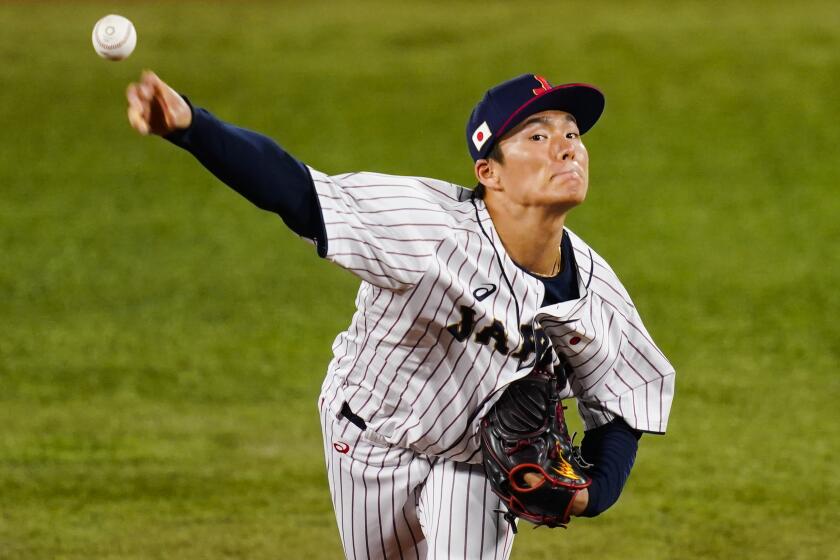Column: Shohei Ohtani’s $680-million loan to Dodgers made Yoshinobu Yamamoto deal possible

- Share via
Shohei Ohtani made this happen.
Shohei Ohtani is why the Dodgers were able to reach an agreement to sign Yoshinobu Yamamoto.
This wasn’t about Ohtani’s recruiting pitch to Yamamoto, who already was said to have an affinity for the Dodgers.
This was about the $680-million loan Ohtani made to the Dodgers.
With Ohtani practically printing money for them, the once-cautious Dodgers made a previously unthinkable move by committing $325 million over 12 years to Yamamoto.
The Dodgers refused to spend that much on Gerrit Cole when he was a free agent four years ago, and there’s no reason to think they would have spent that much on Yamamoto if not for Ohtani insisting they defer the overwhelming majority of his annual $70-million salary without interest.
Japanese pitching ace Yoshinobu Yamamoto agreed to a deal with the Dodgers, joining the newly acquired Shohei Ohtani and Tyler Glasnow on the team.
The structure of Ohtani’s 10-year deal will allow the Dodgers to make Ohtani’s money work for them. In a story recently published in The Times, Dodgers beat reporter Jack Harris quoted an unnamed agent who speculated that the team could make an additional $1 billion by investing the deferrals with an asset management company.
The Dodgers could also make an additional $50 million a year in Ohtani-related advertising and marketing revenue.
No wonder they finally decided to address the single greatest weakness on their roster.
The Dodgers have spent more than $500 million on pitching in a little more than a week. The total cost of Yamamoto will come to $375 million, including the $50 million posting fee they will have to pay to the Orix Buffaloes of the Japanese league. They signed Tyler Glasnow to a five-year, $136.5-million contract after acquiring him in a trade with the Tampa Bay Rays.
Moves such as these are what Ohtani had in mind when he agreed to the unprecedented deferrals.

Ohtani didn’t want to be the reason the Dodgers couldn’t reinforce their roster. He didn’t want to be the reason they wouldn’t have a playoff-worthy rotation, especially with him planning to spend the upcoming season as a full-time designated hitter while recovering from his second Tommy John operation.
The deals for Yamamoto and Glasnow marked departures from the other nine-figure agreements the Dodgers have made under Andrew Friedman. Their other big-money contracts included terms that were extremely favorable to the team. Mookie Betts was acquired in a trade at a minimal cost and signed to an extension with significant salary deferrals. Freddie Freeman landed on their laps after his market crumbled. Trevor Bauer accepted a shorter deal in exchange for higher annual salaries.
The price tags for Yamamoto and Glasnow were considerable when accounting for the risks associated with them.
Yamamoto, 25, was a three-time most valuable player in Japan, but he pitched only once a week in that league. Standing only 5 feet 10, how will his body hold up pitching every five or six days over a 162-game season? He has a well-rounded arsenal, but how will the increased workload affect his fastball, which is already a source of skepticism?
Shohei Ohtani’s unique contract presents an equally unprecedented business opportunity for the Dodgers to make up to $1 billion over the next decade.
Glasnow, 30, is another high-ceiling, low-floor pitcher. The 6-foot-8 Glasnow is one of baseball’s most talented pitchers but has a history of breaking down. He made just 21 starts and registered only 120 innings for the Rays last year, and both figures were career highs.
In short, the Dodgers have invested more than $500 million on an undersized pitcher who has never stepped on a major league mound and a giant who has never stayed healthy.
The Dodgers did right by Ohtani by spending the funds he made available to them. They have to prove themselves worthy stewards of his money, and the only way they could do that is if Yamamoto and Glasnow perform like the frontline pitchers they’re paid to be.
The organization might have felt it was playing with house money, and understandably so. But what was free to the Dodgers was the result of a major sacrifice on the part of Ohtani. He’ll want to see results.
More to Read
Are you a true-blue fan?
Get our Dodgers Dugout newsletter for insights, news and much more.
You may occasionally receive promotional content from the Los Angeles Times.












